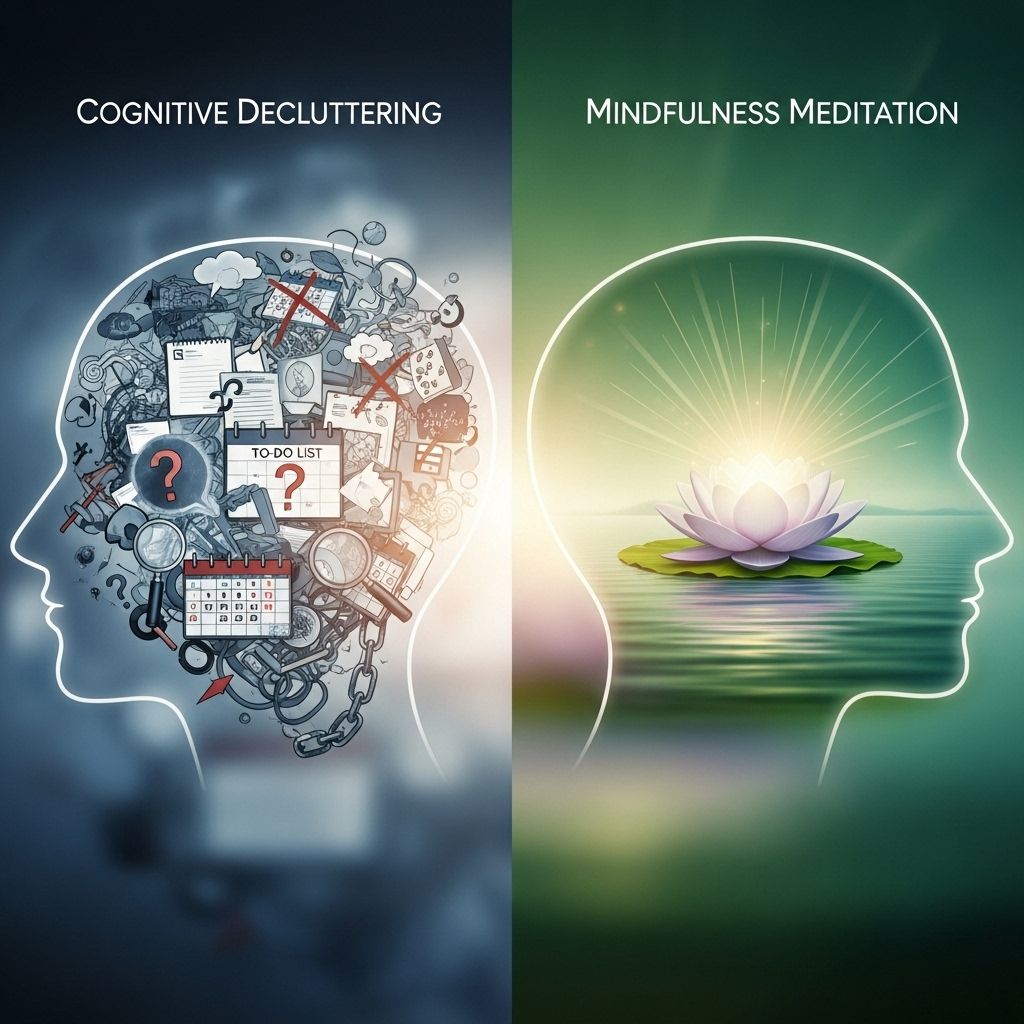Cognitive Decluttering vs. Mindfulness Meditation: A Deep Dive
Clearing mental clutter while staying present reduces stress and enhances clarity.

Table of Contents
n
- n
- Introduction
- What is Cognitive Decluttering?
- What is Mindfulness Meditation?
- Benefits of Cognitive Decluttering
- Benefits of Mindfulness Meditation
- Comparing the Two Techniques
- Frequently Asked Questions
- Conclusion
n
n
n
n
n
n
n
n
nn
Introduction
n
In today’s fast-paced and often cluttered world, both cognitive decluttering and mindfulness meditation have emerged as powerful tools for achieving mental clarity and reducing stress. Cognitive decluttering involves clearing mental and physical spaces to improve focus and productivity, while mindfulness meditation cultivates present-moment awareness to enhance well-being and emotional regulation. This article delves into the principles, benefits, and comparisons of these two practices.
nn
What is Cognitive Decluttering?
n
Cognitive decluttering refers to the process of eliminating unnecessary thoughts, emotions, and distractions from both our minds and surroundings. It involves a mindful approach to decluttering physical spaces, which can significantly impact mental clarity and stress levels. By removing clutter, individuals can reduce visual distractions, improve organizational skills, and enhance their ability to concentrate.
n
Cognitive decluttering is not just about physical space; it also involves managing mental clutter, such as unnecessary worries or unhealthy thoughts. This practice helps individuals focus on what truly matters, leading to a more streamlined and efficient lifestyle.
nn
What is Mindfulness Meditation?
n
Mindfulness meditation is a practice that involves focusing on the present moment, often through techniques like deep breathing, body scan, or guided meditation. It aims to cultivate awareness of thoughts, feelings, and bodily sensations without judgment, allowing individuals to better manage stress and emotions.
n
Mindfulness meditation has been extensively studied for its benefits in reducing anxiety and depression, improving emotional regulation, and enhancing overall well-being. Regular practice can lead to significant changes in brain structure and function, contributing to long-term mental health improvements.
nn
Benefits of Cognitive Decluttering
n
Cognitive decluttering offers several benefits for mental health and productivity:
n
- n
- Reduced Stress and Anxiety: By clearing out clutter, individuals can feel more relaxed and organized, reducing feelings of overwhelm and stress.
- Improved Productivity: Decluttering helps reduce time spent searching for lost items or dealing with distractions, allowing for more efficient use of time.
- Better Mental Clarity: Cognitive decluttering can lead to clearer thinking and decision-making, as mental space is freed from unnecessary thoughts and distractions.
- Enhanced Well-being: This practice can lead to a sense of accomplishment and satisfaction, contributing to a healthier lifestyle.
n
n
n
n
nn
Benefits of Mindfulness Meditation
n
Mindfulness meditation provides numerous benefits for emotional and mental well-being:
n
- n
- Emotional Regulation: Regular practice helps manage stress and emotions, leading to better emotional stability.
- Improved Focus and Concentration: Mindfulness meditation enhances cognitive function by improving attention and reducing mind-wandering.
- Boosted Mood: It can help reduce symptoms of depression and anxiety, promoting a more positive outlook on life.
- Increased Self-Awareness: Practitioners gain a deeper understanding of their thoughts and feelings, allowing for more mindful decision-making.
n
n
n
n
nn
Comparing the Two Techniques
n
While both cognitive decluttering and mindfulness meditation are effective strategies for achieving mental clarity and stress relief, they serve different purposes and offer distinct benefits:
n
| Aspect | Cognitive Decluttering | Mindfulness Meditation |
|---|---|---|
| Purpose | Eliminate physical and mental clutter to enhance productivity and clarity. | Cultivate present-moment awareness to improve emotional regulation and well-being. |
| Benefits | Improved organization, reduced stress, better mental clarity. | Enhanced emotional stability, improved focus, better mood regulation. |
| Methodology | Involves organizing and decluttering physical spaces and managing mental distractions. | Uses mindfulness techniques like meditation and deep breathing to focus on the present moment. |
nn
Frequently Asked Questions
n
Q: How do I start cognitive decluttering?
n
A: Begin by identifying areas of clutter, whether physical or mental, and create a plan to systematically address each area. Start small and focus on one area at a time for maximum impact.
nn
Q: Is mindfulness meditation suitable for everyone?
n
A: Yes, mindfulness meditation is generally suitable for most people. However, those with severe mental health conditions or recent trauma may want to consult a healthcare professional before starting.
nn
Q: Can I practice both cognitive decluttering and mindfulness meditation together?
n
A: Absolutely. Combining these practices can enhance their benefits. For example, using mindfulness during the decluttering process can make it more meaningful and effective.
nn
Conclusion
n
In conclusion, both cognitive decluttering and mindfulness meditation offer powerful tools for improving mental health and well-being. Cognitive decluttering helps clear physical and mental spaces to enhance productivity and clarity, while mindfulness meditation cultivates present-moment awareness to improve emotional regulation and stability. By understanding the principles and benefits of each practice, individuals can choose the approach that best suits their needs, or combine them for a holistic approach to mental wellness.
References
- https://mobileskips.com.au/decluttering-and-mindfulness
- https://dash.harvard.edu/bitstreams/74c98c57-c511-44c3-a204-00e56409666a/download
- https://ahead-app.com/blog/mindfulness/mind-clearing-vs-meditation-which-technique-brings-faster-mental-clarity
- https://ahead-app.com/blog/mindfulness/clearing-your-cluttered-mind-digital-minimalism-vs-mental-decluttering
- https://www.nuvancehealth.org/health-tips-and-news/how-clutter-affects-your-brain-health
- https://mindsolsarasota.com/spring-cleaning-for-the-mind-declutter-for-mental-health/
- https://www.tripp.com/blog/decluttering-your-mind-for-a-happier-you/
- https://zenhabits.net/zen-clutter/
Read full bio of medha deb












